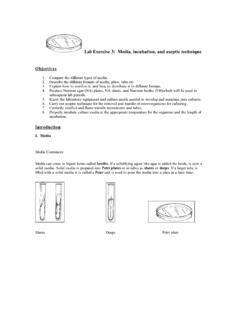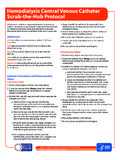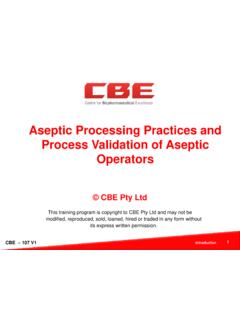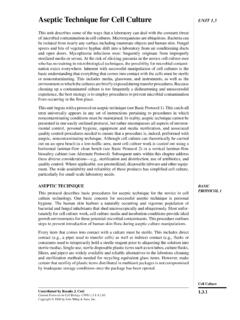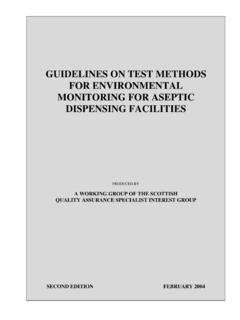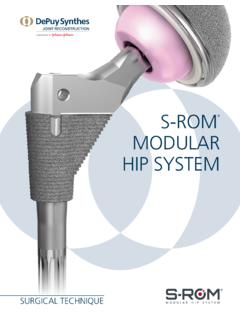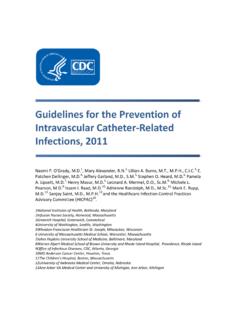Transcription of active substance, excipient and primary container ...
1 6 March 2019. EMA/CHMP/CVMP/QWP/850374/2015. Committee for Medicinal Products for Human use (CHMP). Committee for Medicinal Products for Veterinary use (CVMP). Guideline on the sterilisation of the medicinal product, active substance , excipient and primary container Draft agreed by QWP and BWP December 2015. Adopted by CHMP for release for consultation January 2016. Adopted by CVMP for release for consultation February 2016. Start of public consultation 13 April 2016. End of consultation (deadline for comments) 13 October 2016. Agreed by BWP July 2018. Agreed by CAT September 2018. Agreed by QWP and GMDP IWG October 2018. Adopted by CHMP for publication 15 November 2018. Adopted by CVMP for publication 6 December 2018. Date for coming into effect 1 October 2019.
2 This guideline replaces the document Decision trees for the selection of sterilisation methods (CPMP/QWP/054/98), which is an annex to the note for guidance on development pharmaceutics (CPMP/QWP/155/96); and the document Decision trees for the selection of sterilisation methods (EMEA/CVMP/065/99) which is an annex to the note for guidance: Development pharmaceutics for veterinary medicinal products (EMEA/CVMP/315/98). Official address Domenico Scarlattilaan 6 1083 HS Amsterdam The Netherlands Address for visits and deliveries Refer to Send us a question Go to Telephone +31 (0)88 781 6000 An agency of the European Union European Medicines Agency, 2019. Reproduction is authorised provided the source is acknowledged. Keywords active substance , aseptic processing, container , Decision trees, excipients , Filtration, Finished Dosage form, Sterilisation, Sterilisation assurance level, Terminal sterilisation, Post- aseptic processing terminal heat treatment.
3 Guideline on the sterilisation of the medicinal product, active substance , excipient and primary container EMA/CHMP/CVMP/QWP/850374/2015 Page 2/25. Guideline on sterilisation of the medicinal product, active substance , excipient and primary container Table of contents 1. Introduction (background) ..4. 2. 3. Legal 4. General requirements ..5. Requirements for the manufacture of sterile medicinal products and sterile components6. Steam sterilisation ..7. Dry heat sterilisation ..9. Ionization radiation sterilisation ..10. Gas sterilisation ..11. Sterile filtration ..12. aseptic processing ..14. Good manufacturing practice for sterile active substances, sterile excipients and sterile containers ..14. active substances ..15. excipients .
4 15. Containers ..15. Selection of sterilisation method ..16. 5. Decision trees ..18. 6. Definitions ..21. 7. Guideline on sterilisation of the medicinal product, active substance , excipient and primary container EMA/CHMP/CVMP/QWP/850374/2015 Page 3/25. Executive summary Guidance is provided on the selection of appropriate methods of sterilisation for sterile products. Although, terminal sterilisation using a reference condition of the European Pharmacopoeia (Ph. Eur.). is the method of choice whenever possible, this guideline provides information on when other terminal sterilisation processes, sterilising filtration or aseptic processing, (either alone or when combined with an additional post- aseptic processing terminal heat treatment), could be accepted as an alternative.
5 Guidance is provided on the documentation expected for sterile finished products, sterile active substances, sterile excipients and sterile primary containers (referred to as container in this guideline). in a new marketing authorisation application or a variation application for a medicinal product, (called quality dossier throughout the guideline). Terminology definitions are included at the end of the document. 1. Introduction (background). Sterility is a critical quality attribute for all sterile substances, products and containers. Sterility cannot be assured by testing, it needs to be assured by the use of a suitably designed, validated and controlled manufacturing process. Sterility is achieved by controlling several factors such as the bioburden, the sterilisation procedure, the integrity of the container closure system and in the case of aseptic processing, the use of satisfactory aseptic technique .
6 Terminal sterilisation is preferred to sterilisation by filtration and/or aseptic processing because it is lethal to micro-organisms and a reliable sterility assurance level (SAL) is possible to calculate, validate and control, and thus incorporates a safety margin. For sterile filtration followed by aseptic processing, this is not applicable as accidental contamination caused by inadequate technique cannot be reliably eliminated by monitoring and control. Therefore, terminal sterilisation provides the highest assurance of sterility and should be used whenever possible. For highly sensitive products, such as most biological products, where terminal sterilisation of the finished product is not possible, sterile filtration and/or aseptic processing under validated and controlled conditions can be accepted.
7 Sterile filtration and aseptic processing are closely related and difficult to consider separately, since sterile filtration in most cases is followed by at least one aseptic processing step such as filling. In order to focus on the most important aspect of filtration and aseptic processing at each section of this guideline, only one of the two steps may be mentioned, even if both steps are related. In addition to those finished products where the formulation itself prohibits the possibility of terminal sterilisation, the use of aseptic processing can be accepted in certain situations, even if the formulation itself can be terminally sterilised, if other benefits are gained for patients or users of the product. These situations are specified below in section container integrity is discussed in ICH Q8, (adopted for human medicinal products only, nevertheless the same principles are also applicable to veterinary medicinal products and containers of sterile substances and containers).
8 2. Scope The guideline applies to chemical and biological medicinal products for human and veterinary use but is not applicable to immunological veterinary medicinal products. Guideline on sterilisation of the medicinal product, active substance , excipient and primary container EMA/CHMP/CVMP/QWP/850374/2015 Page 4/25. It is acknowledged that the recommendations provided for in this guideline may require some adaptation to the specific characteristics of Advanced Therapy Medicinal Products (ATMPs) for human use ( difficulties to differentiate between starting material, active substance and finished product in some cases, scarcity of starting materials/ active substance /finished product (autologous products and matched-donor scenario), small volumes of production).
9 The level of documentation that is expected to be included in marketing authorisation applications for ATMPs may be adapted provided that this is justified under a risk-based approach. For veterinary cell based novel therapies, cross reference is made to EMA/CVMP/ADVENT/751229/2016 Questions and Answers on allogenic stem cell-based products for veterinary use: specific questions on sterility. Guidance is provided on the choice of sterilisation method, the development data and manufacturing data required to demonstrate the suitability of the selected sterilisation process. The same principles (choice of method of sterilisation, development data and manufacturing data) apply to sterile active substances, excipients and primary containers.
10 Only the information expected in the quality dossier, including information related to Good Manufacturing Practice (GMP) certificates, is described. Not all GMP requirements ( environmental monitoring, sterilisation of manufacturing equipment) are referenced in the guideline, only those that are considered specifically relevant for the quality dossier. The scope of this document includes: Terminal sterilisation by steam, dry heat and ionising irradiation using the reference conditions of Ph. Eur. Methods of preparation of sterile products or other conditions stated in that monograph Sterilisation by filtration and aseptic processing Sterilisation by gas The concepts in this guideline refer only to absence or removal of bacteria, fungi and bacterial endotoxins.










